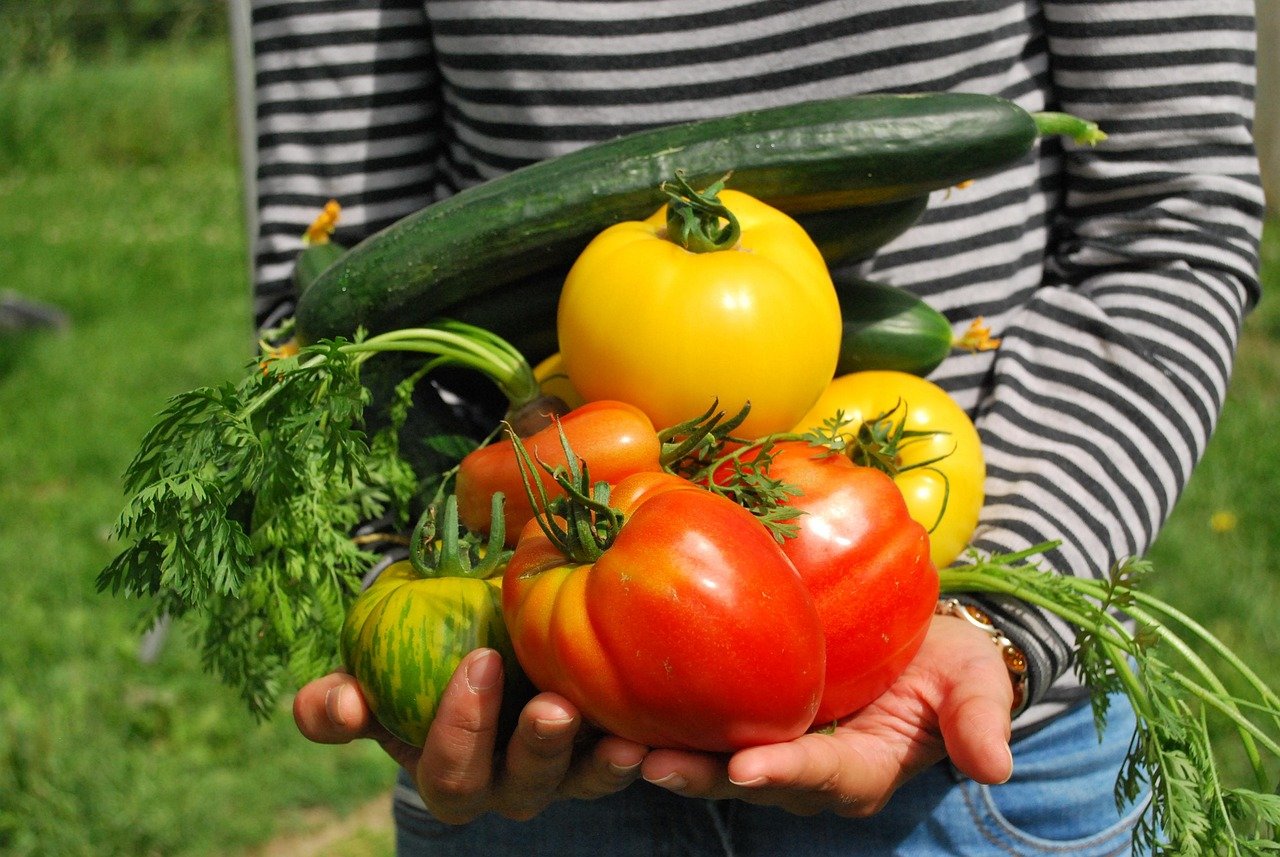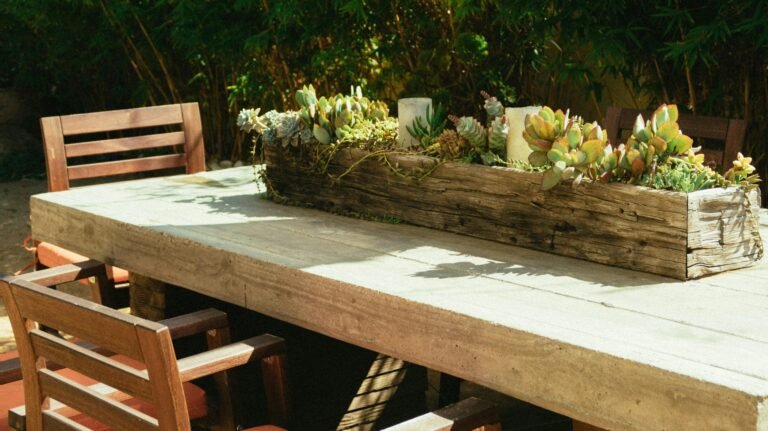You’ve thought about it before… but maybe you weren’t sure how to start a vegetable garden at home. Maybe when you saw someone post a basket of homegrown tomatoes on Instagram, or when supermarket veg looked a bit sad and overpriced. You’ve got a balcony, a patch of garden, or even just a few pots — and you’re wondering, could I really grow my own vegetables?
The short answer? Yes. Even if you’ve never kept a plant alive in your life, you can learn how to start a vegetable garden at home step by step.
Starting a vegetable garden at home can feel overwhelming — all the talk about compost, spacing, crop rotation… It’s enough to make anyone hesitate. But here’s the thing: you don’t need to know everything. You just need to know where to begin.
This guide walks you through exactly that — the beginning. No jargon, no complicated instructions. Just simple steps to help you get started, feel confident, and actually enjoy growing your own food. Think of this as your personal beginner vegetable gardening guide. Whether you’ve got a garden, a balcony, or just a few containers by the kitchen window, you’ll learn what works, what doesn’t, and how to avoid common mistakes. This really is vegetable gardening for beginners – no jargon, just the basics that work.
Because gardening shouldn’t be intimidating — it should be fun, calming, and a bit magical. Let’s get into it.
Why Grow Your Own Veg?
There’s something deeply satisfying about eating food you’ve grown yourself. It’s not just about saving money (though that’s a bonus). It’s the joy of watching something sprout from a seed, the calm that comes from digging your hands into soil, and the pride you feel when you pick your first ripe tomato. That’s one of the biggest rewards of discovering how to start a vegetable garden at home.
If you need a little more convincing, here are a few reasons why growing your own vegetables is 100% worth it – even as a beginner:
1. It Tastes Better
Homegrown veg doesn’t sit in cold storage or get sprayed with preservatives. It goes straight from garden to plate, and the taste difference is unreal, especially with things like tomatoes, lettuce, and herbs. I’ll never forget the taste of my first homegrown lettuce. It was sweeter and crunchier than anything I’d ever bought at the supermarket.
2. It’s Cheaper in the Long Run
Sure, there’s a small start-up cost for soil, pots, and seeds. But once you’re set up, growing your own means fewer trips to the supermarket and less waste. One packet of lettuce seeds can keep you going for months.
3. It’s Good for Your Mind
Gardening is like therapy. Studies show it can reduce stress, improve mood, and even help with anxiety. There’s something about caring for plants that makes the world feel a bit quieter and more manageable. According to the Royal Horticultural Society, gardening is not only a rewarding way to grow food, it also has proven benefits for stress relief and overall wellbeing.
4. You Know Exactly What’s In It
No weird chemicals. No plastic packaging. You’re in full control of what goes into your food and your soil.
5. It’s a Life Skill
Once you learn the basics, you’ll always know how to grow something — whether it’s in a garden, on a balcony, or even indoors. It’s empowering and oddly addictive.
What You’ll Need to Start a Vegetable Garden
These are the basics you’ll need if you want to learn how to start a vegetable garden at home the easy way. You don’t need a fancy greenhouse, acres of land, or a shed full of tools. Starting a vegetable garden at home can be simple and affordable. Here’s a rundown of the basic essentials to get you going — whether you’ve got a garden, a patio, or just a sunny windowsill.
1. A Spot With Sunlight
Vegetables love sunlight — most need at least 6 hours of direct sun per day. Check where the sun hits your space and plan your setup there. Got a shady garden? Don’t worry — some crops like spinach, lettuce, and kale are more forgiving.
Tip: If you’re short on outdoor space, don’t rule out windowsills or balconies. Containers and pots work just fine.
2. Containers or Ground Space
You can grow veg in almost anything that holds soil. Pots, grow bags, raised beds, wooden crates, even old buckets (just drill drainage holes). If you have ground space, you can plant directly into the soil, but make sure it’s free of weeds and reasonably loose.
Good to start with: 20-30cm deep containers for most vegetables. Herbs and salad leaves can do with even less.
3. Soil or Compost
Healthy soil is the foundation of a good garden. You can use shop-bought compost (look for “vegetable or multipurpose compost”) or improve garden soil by mixing it with compost or organic matter. Avoid soil that’s too heavy or clay-like for containers. Healthy soil is a must if you want to succeed with starting a vegetable garden at home. The University of Minnesota Extension notes that good soil structure, added compost, and periodic soil testing are essential for healthy plant growth. In my own garden, I learned quickly that cheap soil held my plants back. Once I invested in decent compost, everything grew twice as fast.
Budget tip: Garden centres often sell bags of compost at discount prices late in the day or season.
4. Seeds or Starter Plants
One of the simplest tricks when learning how to start a vegetable garden at home is choosing seedlings instead of seeds. Seeds are cheaper and give you more variety, but they take a little longer. Starter plants (also called seedlings or plugs) are easier for beginners because they’re already established.
Start with easy-to-grow varieties like:
- Lettuce
- Tomatoes (cherry ones are best for containers)
- Courgettes
- Spring onions
- Radishes
- Herbs (like basil, mint, parsley)
5. Basic Tools
You don’t need much here. Just a few essentials:
- A small hand trowel (for digging and planting)
- A watering can or hose
- Gardening gloves (optional but helpful)
That’s it. No need to go full Alan Titchmarsh from day one. With just these few essentials, you’ll be fully equipped for learning how to start a vegetable garden at home.
Step-by-Step: How to Start a Vegetable Garden at Home
When I planted my very first tomato seedling, I had no idea what I was doing. But within weeks I saw it thriving on my balcony, and that gave me the confidence to keep going. You’ve got your spot, your tools, and your seeds or plants. Now what? Here’s a simple, no-fuss breakdown of how to get your vegetable garden up and running — no green thumb required.
1. Choose Your Space Wisely
Look for the sunniest spot you’ve got — six hours of sunlight a day is ideal. It could be:
- A patch of soil in your garden
- A row of containers on your patio
- A few pots lined up on your balcony or windowsill
Quick check: Watch the area over the course of a day. Morning to early afternoon sun is perfect.
2. Pick Just a Few Veg to Start
Don’t plant everything under the sun. Focus on 2–4 vegetables you actually like to eat and that are easy to grow. Some great starter options:
- Lettuce or spinach (quick-growing and forgiving)
- Tomatoes (especially cherry varieties)
- Radishes (fast results, great for kids too)
- Courgettes (high yield from one plant)
- Herbs like basil or mint (grow well in pots)
The first year I tried growing everything at once, I got overwhelmed. The next season, I stuck with lettuce, tomatoes, and basil and it was so much easier.
3. Prep Your Soil or Containers
If you’re planting in the ground:
Clear the area of grass and weeds. Loosen the soil with a fork and mix in some compost to improve drainage and nutrition.
If you’re using containers:
Make sure they have drainage holes. Fill with multipurpose compost, leaving a couple of centimetres at the top so water doesn’t overflow.
4. Plant Your Seeds or Seedlings
Follow the instructions on your seed packet — they’ll tell you how deep and how far apart to plant. As a rule:
- Tiny seeds (like lettuce) can go just under the surface.
- Bigger seeds (like beans or peas) need about 2–5cm depth.
- Seedlings should be planted at the same depth they were in their original pot.
Tip: Water the soil before you plant — this helps prevent seeds from being washed away.
5. Water Gently, But Regularly
Water your veg in the morning or early evening. The soil should be moist, not soaking. In hot weather, check daily. For containers, you’ll likely need to water more often than with garden beds.
How to tell if your plants need water:
Stick your finger about 2cm into the soil. If it feels dry, water it.
6. Label Your Plants
You’ll thank yourself later. Even if you think you’ll remember what you planted, you won’t. Use wooden sticks, lolly sticks, or even cut-up plastic containers to mark what’s what.
Beginner-Friendly Vegetables for Your Home Garden
If you’re wondering how to start a vegetable garden at home, the goal is simple: choose easy vegetables to grow at home that will give you fast results. You want veggies that grow quickly, don’t ask for much, and give you a taste of success early on. Here are the best ones to start with – whether you’ve got a garden bed, some pots, or even a windowsill.
🥬 1. Lettuce & Salad Leaves
Fast-growing and low effort. You can sow seeds straight into containers or beds and start harvesting baby leaves in just a few weeks. They grow back after cutting, so you’ll get multiple harvests.
Needs: Light watering, partial sun is fine
Best for: Small containers, window boxes
🍅 2. Cherry Tomatoes
They love sun and warmth, and you’ll get loads from one plant. You can grow them in pots, hanging baskets, or grow bags. Look for bush varieties (like ‘Tumbling Tom’) — they don’t need staking or tying up.
Needs: Full sun, regular watering, liquid feed
Best for: Containers, balconies, sunny patios
🌱 3. Radishes
Radishes grow ridiculously fast — you can go from seed to harvest in under a month. Great for instant gratification.
Needs: Loose soil, regular watering
Best for: Raised beds, containers
The Old Farmer’s Almanac also lists radishes as one of the easiest crops to grow at home, making them a perfect choice for beginners.
🌿 4. Herbs (Basil, Mint, Parsley)
Perfect for windowsills and small spaces. Herbs are forgiving and handy in the kitchen. Just watch out for mint — it spreads fast, so best to keep it in its own pot.
Needs: Good drainage, regular light
Best for: Indoor pots, balconies, container gardens
I keep a pot of mint on my windowsill. It grows like crazy, and nothing beats adding fresh leaves to tea or salads straight from the plant.
🥒 5. Courgettes (Zucchini)
Just one plant can give you more courgettes than you know what to do with. They need a bit more space but are very beginner-friendly.
Needs: Room to spread, plenty of sun, rich soil
Best for: Raised beds, large containers
🧅 6. Spring Onions
These grow quickly and don’t need much space. Sow a bunch of seeds close together, and harvest when they’re about the size of a pencil.
Needs: Moist soil, good drainage
Best for: Small containers or narrow garden strips
Choose two or three of these to start with. It’s better to grow a little well than try to manage too much and feel overwhelmed. These easy crops will give you quick wins and confidence as you master how to start a vegetable garden at home.
Planting & Caring Basics
You’ve got your seeds in the soil and your containers in the sun — now what? This is where the magic happens. Here are some practical home vegetable garden tips to keep things thriving. Don’t worry, it’s not complicated. Think of it like brushing your teeth: a little bit of daily care goes a long way.
💧 1. Watering
Most beginner mistakes come down to watering — either too much or not enough. The trick is to keep the soil consistently moist, not soggy. Watering is the number one challenge for beginners learning how to start a vegetable garden at home.
Quick tips:
- Stick your finger into the soil. If it’s dry 2cm down, it’s time to water.
- Water early in the morning or late afternoon to avoid evaporation.
- For containers, water more often — they dry out faster than garden beds.
- Try not to water the leaves — water at the base to avoid disease.
I used to overwater my basil until I learned the finger test. Now I only water when the soil feels dry, and my plants are much healthier.
☀️ 2. Sunlight
Plants need light to grow strong and healthy. As mentioned earlier, aim for:
- 6+ hours of sun per day for most veg
- If you’ve got partial shade, choose leafy greens over fruiting plants
Not enough light? You might notice spindly stems or slow growth. Try moving your containers to a sunnier spot. Getting enough sun is one of the most important parts of mastering how to start a vegetable garden at home successfully.
🍽️ 3. Feeding Your Plants
Plants need nutrients to grow — especially if you’re growing in pots, where nutrients wash out over time.
For beginners:
Use a general-purpose liquid fertiliser every couple of weeks once your plants start growing. Don’t overdo it — too much feed can burn the plants or lead to leafy growth with no fruit.
Organic option: A handful of compost or worm castings added to the top of the soil every few weeks.
🐛 4. Pests & Problems
Every garden gets pests — don’t panic. Here’s how to deal:
- Aphids (greenfly): Blast off with water or wipe with soapy water
- Slugs/snails: Try crushed eggshells, copper tape, or go out after dark and pick them off
- Yellowing leaves: Usually a sign of overwatering or poor drainage
- Spots/mould: Remove affected leaves and make sure there’s good air circulation
Key point: Don’t let a few bugs or yellow leaves throw you off. Plants are tougher than you think.
✂️ 5. Pruning & Pinching (Optional but Helpful)
- For herbs like basil, pinch the tops off regularly to encourage bushy growth.
- For tomatoes, remove the little shoots that grow between the main stem and branches (“suckers”) to focus the plant’s energy on fruit.
Stick to the basics: water regularly, give your plants sun, and check in on them each day. Think of it as a quick five-minute ritual. That’s all it takes to keep your garden thriving.
Common Mistakes to Avoid
Everyone makes mistakes in vegetable gardening for beginners – it’s part of the process.. But if you know what to look out for, you can dodge the biggest pitfalls and keep things on track. Here are the most common beginner slip-ups (and how to avoid them).
❌ 1. Planting Too Much, Too Soon
It’s tempting to grow everything all at once — but it’s also a fast track to overwhelm. Start small with just a few veg, and build up as you gain confidence.
Fix: Choose 2–4 easy vegetables and master those first.
❌ 2. Overwatering
More water doesn’t mean happier plants. In fact, too much water can rot roots and invite disease.
Fix: Only water when the top 2–3cm of soil feels dry. And make sure your containers have drainage holes.
❌ 3. Not Enough Sunlight
Many vegetables, especially fruiting ones like tomatoes or courgettes, need a lot of sun to thrive.
Fix: Track your sunniest spot and use it. If in doubt, choose leafy greens which cope better with part shade.
❌ 4. Ignoring Spacing Guidelines
Crowding your plants means they’ll compete for light, water and nutrients — and nobody wins.
Fix: Check the seed packet or plant label for spacing recommendations. It really does make a difference.
❌ 5. Forgetting to Feed
Plants grown in pots quickly use up the nutrients in the soil. If they’re not getting fed, they’ll grow slowly and produce less.
Fix: Use a general-purpose liquid fertiliser every 2–3 weeks, or top up with compost.
❌ 6. Giving Up After the First Setback
One plant dies, a few leaves go yellow, or a slug eats your lettuce — and it feels like you’ve failed.
Fix: Remind yourself this is normal. Every gardener has a plant graveyard. Learn from it, adjust, and keep going.
Mess-ups are part of the fun. They teach you what works in your space, with your conditions. And the beauty of gardening? You always get another chance next season.
When and How to Harvest
The most exciting part of learning how to start a vegetable garden at home is finally harvesting your own food. This is the bit you’ve been waiting for – the moment you get to pick and eat what you’ve grown. But knowing when to harvest can be just as important as growing the stuff in the first place. Leave things too long and they can turn woody, bitter, or overripe. Harvest too early and you miss out on flavour and yield. Once you understand how to start a vegetable garden at home, the next joy is learning when to harvest your crops.
Here’s how to get it right:
🥬 Lettuce & Salad Leaves
- When to harvest: When leaves are about 10–15cm tall.
- How: Snip off outer leaves with scissors and leave the centre to keep growing (this is called “cut and come again”).
🍅 Tomatoes
- When to harvest: When they’re fully coloured (red, yellow, or orange, depending on the variety) and slightly soft to the touch.
- How: Twist or snip off gently at the stem.
🌿 Herbs
- When to harvest: As soon as they’re about 10–15cm tall. The more you pick, the more they grow.
- How: Snip leaves or stems just above a leaf pair — this encourages bushier growth.
🥒 Courgettes
- When to harvest: When they’re 10–15cm long. Pick them young — they’re more tender and tasty.
- How: Use a knife or secateurs to cut them off cleanly.
🌱 Radishes
- When to harvest: Around 3–4 weeks after sowing, when they’re about 2–3cm wide.
- How: Gently pull them up from the base of the leaves.
🧅 Spring Onions
- When to harvest: When they’re about the width of a pencil.
- How: Tug them up gently from the base.
Top tip: Don’t wait for everything to be perfect. Homegrown veg isn’t supposed to look supermarket-perfect — it’s fresher, tastier, and has its own charm. Pick it when it looks ready to you.
Final Tips + Encouragement
Starting a vegetable garden isn’t about perfection — it’s about progress. You’re learning a new skill, building a new habit, and literally growing your own food. That’s a big deal.
Here are a few last tips to help you stick with it and enjoy the process:
🌱 Keep It Small and Simple
You don’t need to grow everything at once. Even one pot of lettuce or a single tomato plant is a great start. Small successes build confidence.
📓 Take Notes
Keep a little gardening notebook or use your phone to jot down what you planted, when you watered, and what worked well. It helps you improve each season — and it’s actually fun to look back on.
🔁 Don’t Be Afraid to Start Over
Some plants will flop. It happens to everyone. Just pull them out, refresh the soil, and try again. That’s how gardeners are made.
💬 Ask Questions
Gardening is one of those hobbies where people love to share tips. Chat to your neighbour, join a Facebook group, or pop into your local garden centre. You’ll learn heaps just by asking.
🍴 Celebrate the Wins
Picked your first courgette? Snipped a handful of mint for your tea? That’s a win. Use your harvest, no matter how small — it’s the reward for your care and patience. Even the easiest vegetables to grow at home can feel like a huge achievement. One of my proudest moments was harvesting enough cherry tomatoes for a full salad. A small harvest, but incredibly satisfying.
Remember: anyone can figure out how to start a vegetable garden at home, it just takes patience and consistency. Here’s the truth: You don’t need a green thumb. You just need to start.
With a bit of sunlight, some decent soil, and a few minutes of care each day, you’ll discover exactly how to start a vegetable garden at home and enjoy fresh, homegrown food far more than you ever expected. This beginner vegetable gardening guide is just the start.
Now go plant something!
📍 FAQ: How to Start a Vegetable Garden at Home (Beginner’s Guide to Success)
Alex is the creator of Homely Haven, a space dedicated to simple, stylish ideas for interiors and gardens alike. With a passion for cozy living rooms, inviting outdoor spaces, and practical DIY solutions, Alex shares tips and guides that help turn any house into a true home.
From budget-friendly decorating hacks to weekend garden projects, the goal is always the same: to inspire you to create spaces that feel personal, beautiful, and welcoming. When not writing, Alex is usually rearranging furniture, sketching new garden layouts, or exploring design trends for the next project.








